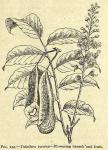 A balsam exuded from the bruised trunk of Tolui'fera perei'reae Baillon.
A balsam exuded from the bruised trunk of Tolui'fera perei'reae Baillon.
BOTANICAL CHARACTERISTICS.—A leafy tree, with wood containing a liquid balsam. Leaves imparipinnate; leaflets 5 to 11, alternate. Racemes 6 to 7 inches long. Fruit a one-celled, one-seeded pod about 3 ¼ inches long; mesocarp fibrous, the inner part with receptacles of oleoresin.
SOURCE AND COLLECTION.—This valuable tree grows in the wild forests of San Salvador, singly or in groups. The trees, owned by individuals, are carefully guarded. The balsam is collected by loosening the bark with a blunt mallet for some distance in four alternate sections so as not to kill the tree. The loosened bark soon splits; it is set on fire and charred, leaving the wood bare. Pockets thus made are covered with rags to absorb the exuding balsam. These, when saturated, are thrown into boiling water, as a means of separating the balsam, which collects at the bottom of the vessel. The annual yield per tree, is about twenty pounds. The fruit yields by expression a white balsam (balsam blanco, white Peru balsam), having a tonkalike odor, which contains a crystallizable resin. The name Myroxylon, as sometimes applied to the balsam, suggests the fact that for a long time it was supposed to be derived from a species of Myroxylon (M. peruiferum).
DESCRIPTION OF DRUG.—A brownish-black, oleoresinous, non-viscous liquid, transparent in thin layers, and, by transmitted light, a bright red-brown; heavier than water; odor balsamic and vanilla-like; taste warm, bitterish, afterward acrid.
CONSTITUENTS.—Benzoic and cinnamic acid, cinnamein (the cinnamate of benzyl alcohol) constituting the greater part, about 60 per cent.; resin 32 per cent., and small quantities of benzyl alcohol, C6H5CH2-CH2OH; benzylic benzoate, C7H5(C7H7)O2; stilbene, C14H12; styrol, C8H8; styracin; toluol, C7H8.
ACTION AND USES.—Stimulant, expectorant, and stomachic. Externally in ointment. Dose: 8 to 30 gr. (0.5 to 2 Gm.).

